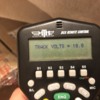I'm kinda behind the times on who's on top nowdays. TTTT, If I went shopping tomorrow, I'd likely ask GRJs opinion.
I'm using a twenty year old Craftsman with fluke innards, a fifty+ year old Simpson, and a few no name units.
For general purpose work you don't need to spend a lot at all. Even cheap analog beats none.
Feature I like most is a peak finder, recalling the peaks of a fluxuating read. Some peak holds only hold the reading taken as you pressed the button, so make sure it isn't one of those. (Craftsman likes to twist wording a lot, selling on hype vs reality.. read, test/play, don't just accept feature hype as gospel. I got bit on that feature not being like the fluke was. Oh well, It was still reading great, so I kept it. Dropped the fluke where it will stay until a building comes down  )
)
A type I don't like, the screen will blank out until a steady read is seen. This kind is near useless imo. You'll spend more time waiting for numbers totsettle o th anything.... if they come at all.
You don't really want one that averages for you either imo. (nice, but not really ”needed")
(spellwreck woke up, time to exit for today  )
)












